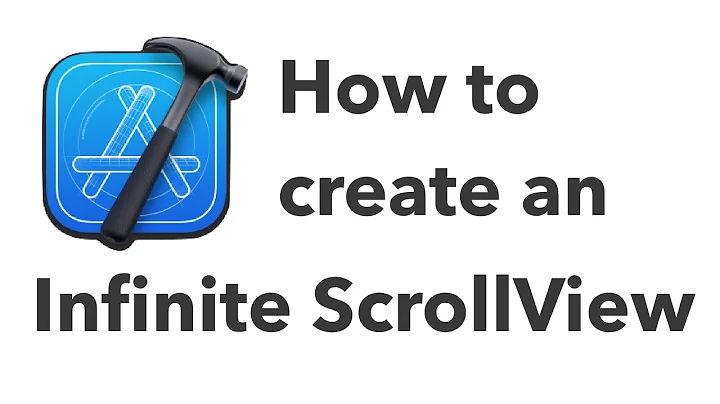How to properly animate UIScrollView contentOffset
Solution 1
Did you try the same approach, but with disabled animation in scrollViewDidScroll ?
On iOS 7, you could try wrapping your code in scrollViewDidScroll in
[UIView performWithoutAnimation:^{
//Your code here
}];
on previous iOS versions, you could try:
[CATransaction begin];
[CATransaction setDisableActions:YES];
//Your code here
[CATransaction commit];
Update:
Unfortunately that's where you hit the tough part of the whole thing. setContentOffset: calls the delegate just once, it's equivalent to setContentOffset:animated:NO, which again calls it just once.
setContentOffset:animated:YES calls the delegate as the animation changes the bounds of the scrollview and you want that, but you don't want the provided animation, so the only way around this that I can come up with is to gradually change the contentOffset of the scrollview, so that the animation system doesn't just jump to the final value, as is the case at the moment.
To do that you can look at keyframe animations, like so for iOS 7:
[UIView animateKeyframesWithDuration:duration delay:delay options:options animations:^{
[UIView addKeyframeWithRelativeStartTime:0.0 relativeDuration:0.5 animations:^{
[self setContentOffset:CGPointMake(floorf(index/2) * elementWidth, 0)];
}];
[UIView addKeyframeWithRelativeStartTime:0.5 relativeDuration:0.5 animations:^{
[self setContentOffset:CGPointMake(index*elementWidth, 0)];
}];
} completion:^(BOOL finished) {
//Completion Block
}];
This will get you two updates and of course you could use some math and a loop to add up a lot more of these with the appropriate timings.
On previous iOS versions, you'll have to drop to CoreAnimation for keyframe animations, but it's basically the same thing with a bit different syntax.
Method 2:
You can try polling the presentationLayer of the scrollview for any changes with a timer that you start at the beginning of the animation, since unfortunately the presentationLayer's properties aren't KVO observable. Or you can use needsDisplayForKey in a subclass of the layer to get notified when the bounds change, but that'll require some work to set up and it does cause redrawing, which might affect performance.
Method 3: Would be to dissect exactly what happens to the scrollView when animated is YES try and intercept the animation that gets set on the scrollview and change its parameters, but since this would be the most hacky, breakable due to Apple's changes and trickiest method, I won't go into it.
Solution 2
A nice way to do this is with the AnimationEngine library. It's a very small library: six files, with three more if you want damped spring behavior.
Behind the scenes it uses a CADisplayLink to run your animation block once every frame. You get a clean block-based syntax that's easy to use, and a bunch of interpolation and easing functions that save you time.
To animate contentOffset:
startOffset = scrollView.contentOffset;
endOffset = ..
// Constant speed looks good...
const CGFloat kTimelineAnimationSpeed = 300;
CGFloat timelineAnimationDuration = fabs(deltaToDesiredX) / kTimelineAnimationSpeed;
[INTUAnimationEngine animateWithDuration:timelineAnimationDuration
delay:0
easing:INTULinear
animations:^(CGFloat progress) {
self.videoTimelineView.contentOffset =
INTUInterpolateCGPoint(startOffset, endOffset, progress);
}
completion:^(BOOL finished) {
autoscrollEnabled = YES;
}];
Solution 3
Try this:
UIView.animate(withDuration: 0.6, animations: {
self.view.collectionView.contentOffset = newOffset
self.view.layoutIfNeeded()
}, completion: nil)
Related videos on Youtube
Lloyd18
Updated on July 09, 2022Comments
-
 Lloyd18 almost 2 years
Lloyd18 almost 2 yearsI have UIScrollView subclass. Its content is reusable - about 4 or 5 views are used to display hundreds of elements (while scrolling hidden objects reused and jumps to another position when its needed to see them)
What i need: ability to automatically scroll my scroll view to any position. For example my scroll view displays 4th, 5th and 6th element and when I tap some button it needs to scroll to 30th element. In other words I need standard behaviour of UIScrollView.
This works fine:
[self setContentOffset:CGPointMake(index*elementWidth, 0) animated:YES];but I need some customisation. For example, change animation duration, add some code to perform on end of animation.
Obvious decision:
[UIView animateWithDuration:3 delay:0 options:UIViewAnimationOptionBeginFromCurrentState animations:^{ [self setContentOffset:CGPointMake(index*elementWidth, 0)]; } completion:^(BOOL finished) { //some code }];but I have some actions connected to scroll event, and so now all of them are in animation block and it causes all subview's frames to animate too (thanks to few reusable elements all of them animates not how i want)
The question is: How can I make custom animation (in fact I need custom duration, actions on end and BeginFromCurrentState option) for content offset WITHOUT animating all the code, connected to
scrollViewDidScrollevent?UPD: Thanks to Andrew's answer(first part) I solved issue with animation inside
scrollViewDidScroll:- (void)scrollViewDidScroll:(UIScrollView *)scrollView{ [UIView performWithoutAnimation:^{ [self refreshTiles]; }]; }But
scrollViewDidScrollmust (for my purposes) executes every frame of animation like it was in case of[self setContentOffset:CGPointMake(index*elementWidth, 0) animated:YES];However, now it executes only once at start of animation.
How can I solve this?
-
 Lloyd18 about 10 yearsThank you! That was so obvious) It helped and now "scrollViewDidScroll" performs without animation. But unlike in case of system animation of "contentOffset" where it performs several times (every frame, I believe) now it performs only ones. Have you ideas how to fix this?
Lloyd18 about 10 yearsThank you! That was so obvious) It helped and now "scrollViewDidScroll" performs without animation. But unlike in case of system animation of "contentOffset" where it performs several times (every frame, I believe) now it performs only ones. Have you ideas how to fix this? -
Andrew about 10 yearsAdded an answer to your comment in my answer, since it'd be quite long for a comment.
-
 Lloyd18 about 10 yearsWonderful answer! Thanks a lot!
Lloyd18 about 10 yearsWonderful answer! Thanks a lot! -
endavid about 8 yearsperformWithoutAnimation doesn't seem to be working for me. I have a gradient layer and I'm updating the alpha, but the gradient layer seems to be always lagging behind, regardless I put the whole code inside performWithoutAnimation :/







